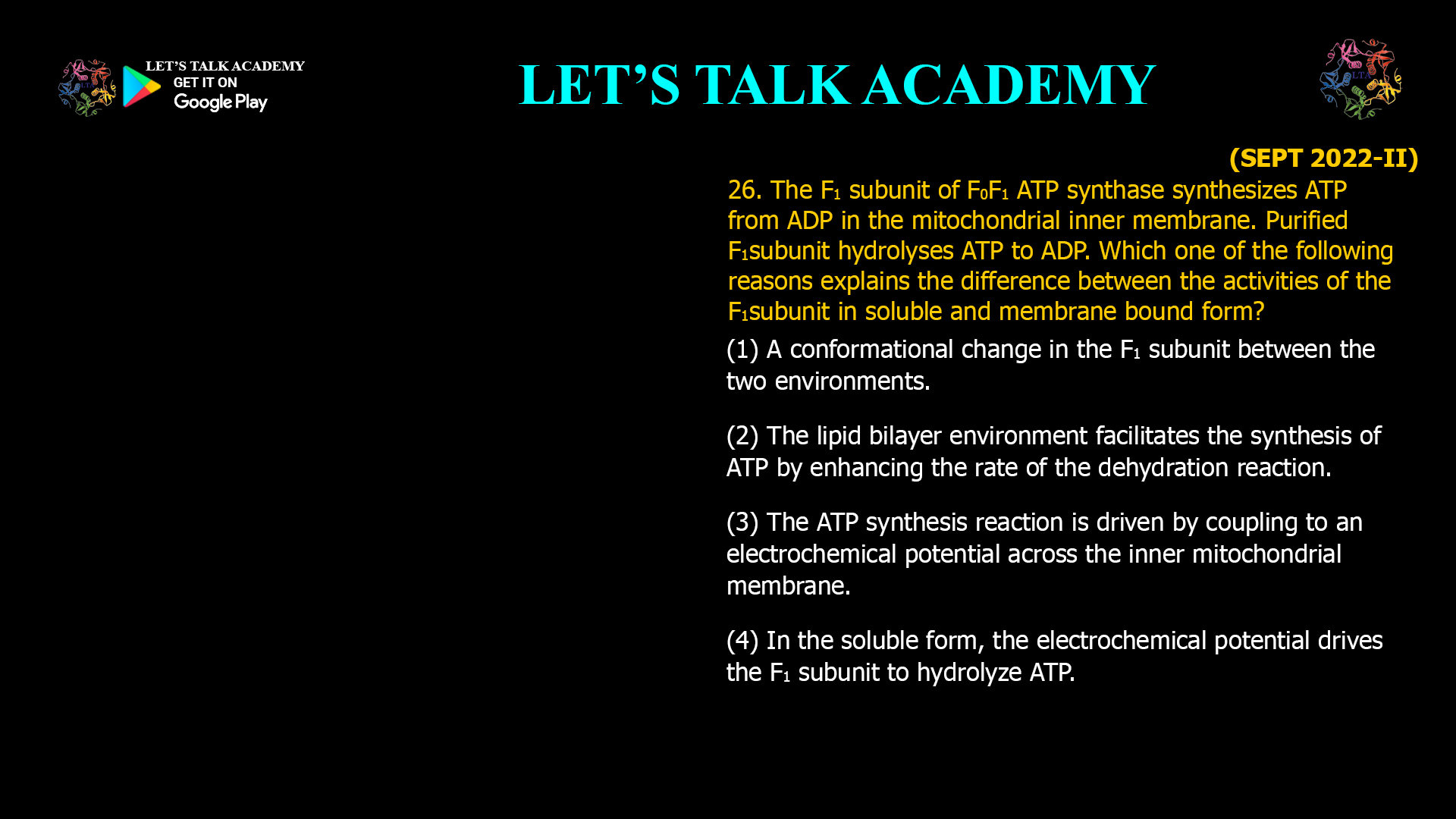26. The F1 subunit of F0F1 ATP synthase synthesizes ATP from ADP in the mitochondrial inner membrane. Purified F1 subunit hydrolyses ATP to ADP. Which one of the following reasons explains the difference between the activities of the F1 subunit in soluble and membrane bound form?
(1) A conformational change in the F1 subunit between the two environments.
(2) The lipid bilayer environment facilitates the synthesis of ATP by enhancing the rate of the dehydration reaction.
(3) The ATP synthesis reaction is driven by coupling to an electrochemical potential across the inner mitochondrial membrane.
(4) In the soluble form, the electrochemical potential drives the F1 subunit to hydrolyze ATP.
ATP synthase is a remarkable molecular machine embedded in the inner mitochondrial membrane that synthesizes ATP, the universal energy currency of the cell. It consists of two main parts: the membrane-embedded F0 portion and the peripheral, soluble F1 portion. While the intact F0F1 complex synthesizes ATP from ADP and inorganic phosphate (Pi) driven by a proton gradient, the isolated F1 subunit, when purified and studied in solution, typically hydrolyzes ATP instead of synthesizing it.
This intriguing difference in activity between the membrane-bound and soluble forms of the enzyme is explained by the fundamental bioenergetic principle that ATP synthesis by ATP synthase is coupled to an electrochemical proton gradient across the inner mitochondrial membrane.
Structure and Function of ATP Synthase
ATP synthase (also called F0F1-ATPase) is composed of:
-
F0 subunit: An integral membrane complex that forms a proton channel. It allows protons to flow down their electrochemical gradient from the intermembrane space into the mitochondrial matrix. This proton flow drives rotation of the c-ring and the central stalk of the enzyme.
-
F1 subunit: A peripheral, water-soluble complex protruding into the mitochondrial matrix. It contains the catalytic sites for ATP synthesis and hydrolysis. The F1 portion consists of a hexameric ring of alternating α and β subunits (α3β3), with a central γ subunit that acts as a rotary shaft.
The proton flow through F0 causes rotation of the central stalk (γ subunit), which induces conformational changes in the β subunits of F1. These conformational changes drive the synthesis of ATP from ADP and Pi by cycling through three states: loose (binding substrates), tight (catalysis), and open (release of ATP).
Why Does the Purified F1 Subunit Hydrolyze ATP?
When the F1 subunit is isolated and removed from the membrane-bound F0 portion, it loses the coupling to the proton gradient. As a result:
-
The proton motive force (PMF), which normally drives the rotary mechanism of ATP synthase in the direction of ATP synthesis, is absent.
-
Without this driving force, the enzyme operates in reverse, functioning as an ATPase that hydrolyzes ATP to ADP and Pi.
-
The F1 subunit alone cannot harness energy from a proton gradient and thus catalyzes the energetically favorable reaction of ATP hydrolysis.
This reversal of activity is a direct consequence of the absence of the membrane-embedded F0 subunit, which couples proton flow to mechanical rotation and catalysis.
Role of the Electrochemical Proton Gradient
The key difference between the membrane-bound and soluble forms lies in the coupling to the electrochemical potential across the inner mitochondrial membrane:
-
In intact mitochondria, the electron transport chain pumps protons out of the matrix, creating a proton gradient (higher proton concentration in the intermembrane space).
-
This gradient stores energy as the proton motive force, which drives protons back through the F0 channel.
-
Proton flow causes rotation of the central stalk, inducing conformational changes in F1 that favor ATP synthesis.
-
The energy from the proton gradient is thus converted into chemical energy stored in ATP.
Without the proton gradient, as in the purified F1 subunit, ATP synthesis is not energetically favored, and the enzyme instead hydrolyzes ATP.
Why Not a Conformational Change Alone?
While conformational changes in the F1 subunit are essential for ATP synthesis, these changes are driven by mechanical rotation powered by proton flow through F0. The isolated F1 subunit cannot undergo the same rotary mechanism without F0 and the proton motive force.
Therefore, the difference in activity is not solely due to a conformational change in F1 between soluble and membrane-bound forms, but primarily due to the presence or absence of the proton motive force coupling.
Summary of the Correct Explanation
| Option | Explanation | Correctness |
|---|---|---|
| (1) A conformational change in the F1 subunit between the two environments. | Incorrect alone; conformational changes depend on proton-driven rotation. | |
| (2) The lipid bilayer environment facilitates ATP synthesis by enhancing dehydration rate. | Incorrect; lipid environment does not directly catalyze ATP synthesis. | |
| (3) The ATP synthesis reaction is driven by coupling to an electrochemical potential across the membrane. | Correct; coupling to proton motive force drives ATP synthesis. | |
| (4) In the soluble form, electrochemical potential drives F1 to hydrolyze ATP. | Incorrect; no electrochemical potential in soluble form. |
Conclusion
The primary reason the purified F1 subunit hydrolyzes ATP while the membrane-bound F0F1 ATP synthase synthesizes ATP is that ATP synthesis requires coupling to the proton motive force across the inner mitochondrial membrane. This electrochemical gradient drives the rotary mechanism of ATP synthase, enabling conformational changes in F1 that catalyze ATP formation. Without this coupling, the F1 subunit operates in reverse, hydrolyzing ATP instead.




7 Comments
Pallavi Ghangas
September 23, 2025ATP synthesis requires coupling to the proton motive force across the inner mitochondrial membrane
Roopal Sharma
September 25, 2025Atp synthesis require coupling pmf across inner mitochondrial mambrane .
Kirti Agarwal
September 24, 2025ATP synthesis require proton motive force for coupling reaction
Heena Mahlawat
September 25, 2025Atp synthesis require proton motive force across inner mitochondrial membrane
Manisha choudhary
September 27, 2025Statement -3 is correct
Kajal
October 4, 2025Coupling to proton motive force generate ATP
Rishu
November 25, 2025Option 3 is the right answer